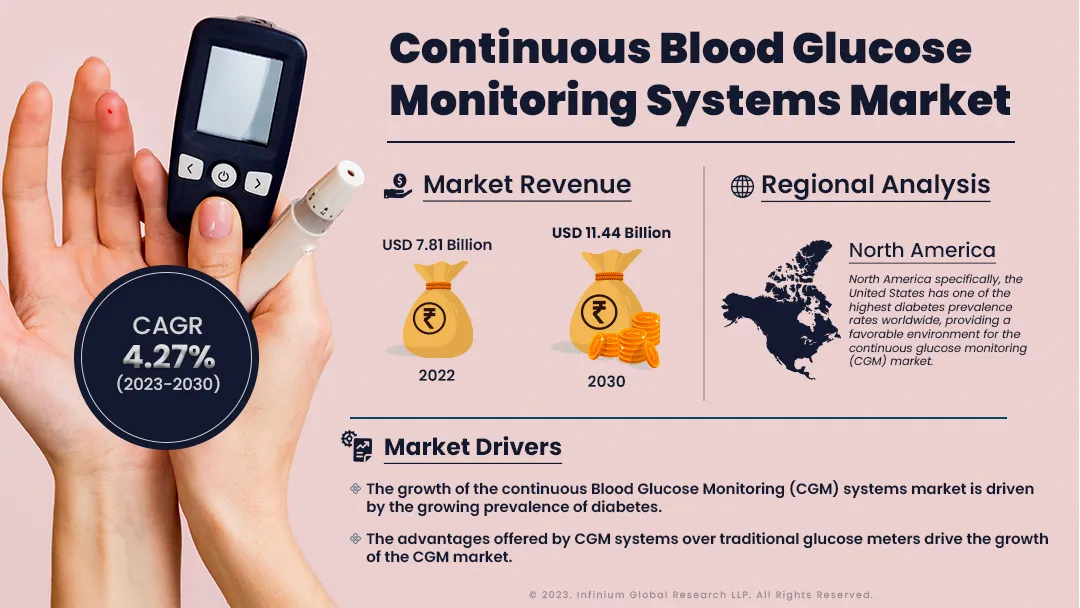Continuous Glucose Monitoring Systems Market (Component - Sensors, Transmitters, and Receivers; Demography - Child Population, and Adult Population; End User - Home Healthcare, and Others): Global Industry Analysis, Trends, Size, Share and Forecasts to 2030
A recent report published by Infinium Global Research on continuous glucose monitoring systems market provides in-depth analysis of segments and sub-segments in the global as well as regional continuous glucose monitoring systems market. The study also highlights the impact of drivers, restraints, and macro indicators on the global and regional continuous glucose monitoring systems market over the short term as well as long term. The report is a comprehensive presentation of trends, forecast and dollar values of global continuous glucose monitoring systems market.
Market Insight:
Continuous Glucose Monitoring (CGM) is a specialized segment within the broader Blood Glucose Monitoring Systems market. It offers a more advanced approach to tracking an individual's blood glucose levels in real-time. Unlike traditional glucose meters that provide single measurements at specific moments, CGM systems use sensors inserted under the skin to continuously monitor glucose levels in the interstitial fluid. These sensors transmit data continuously to a receiver or a smartphone application, enabling users to identify patterns and trends in their glucose levels. This real-time information is crucial for reducing the risk of severe hypoglycemia or hyperglycemia and improving overall control of blood sugar levels. CGM systems are particularly beneficial for individuals who face challenges in achieving their target glucose levels with intermittent glucose meters.
The growth of the Continuous Blood Glucose monitoring (CGM) systems market is propelled by the increasing prevalence of diabetes. This upsurge in the diabetic population has generated a heightened demand for efficient and user-friendly tools to track blood glucose levels. CGM systems have emerged as a pivotal solution, providing real-time and comprehensive monitoring, and empowering individuals to make timely adjustments to their dietary choices, medication, and lifestyle. The advantages presented by CGM systems over traditional glucose meters are the primary drivers behind the CGM market's growth. The real-time monitoring capabilities, coupled with a deeper understanding of glucose fluctuations, significantly enhance the appeal of CGM systems. This increased capability equips individuals with diabetes with more comprehensive insights into their condition, enabling proactive adjustments to maintain glycemic control. However, the market may encounter challenges related to CGM system limitations, potential adverse effects, device comfort, accuracy, and cost. Nonetheless, ongoing advancements in sensor technology and wearable devices offer significant opportunities for the continuous blood glucose monitoring systems market. These innovations have the potential to enhance device accuracy, user comfort, and overall accessibility, further fueling market growth.

North America is projected to hold the most prominent market share in the upcoming forecast period. In North America specifically, the United States has one of the highest diabetes prevalence rates worldwide, providing a favorable environment for the continuous glucose monitoring (CGM) market. This is due to its well-established healthcare infrastructure, comprising healthcare providers, hospitals, clinics, and diabetes care specialists. Moreover, many U.S. insurance providers offer coverage and reimbursement for CGM systems, enhancing accessibility for a wider demographic of diabetes patients. This insurance support acts as a catalyst for the adoption of CGM systems, promoting their utilization in the market. The Asia-Pacific (APAC) region is witnessing rapid growth in the CGM market due to the substantial increase in diabetes prevalence, notably in countries like India and China. As the diabetic population continues to expand, the demand for effective glucose monitoring solutions, including CGM systems, rises. This region presents a promising market for the CGM industry.
Report Scope of the Continuous Glucose Monitoring Systems Market:
| Report Coverage | Details |
|---|---|
| Market Size in 2022 | USD 7.81 Billion |
| Market Size by 2030 | USD 11.44 Billion |
| Growth Rate from 2023 to 2030 | CAGR of 4.27% |
| Largest Market | North America |
| No. of Pages | 255 |
| Market Drivers |
|
| Market Segmentation | By Component, By Demography, and By End User |
| Regional Scope | North America, Europe, Asia Pacific, and RoW |
Segment wise revenue contribution in the global continuous glucose monitoring systems market
The report on global continuous glucose monitoring systems market provides a detailed analysis of segments in the market based on Component, Demography, and End User.
Segmentation Based on Component
· Sensors
· Transmitters
· Receivers
Segmentation Based on Demography
· Child Population
· Adult Population
Segmentation Based on End User
· Home Healthcare
· Others
Company Profiled:
· F. Hoffmann-La Roche Ltd
· Senseonics
· Abbott Laboratories
· A. Menarini Diagnostics s.r.l
· Dexcom, Inc.
· Insulet Corporation
· Ypsomed AG
· Medtronic
· Tandem Diabetes Care, Inc.
· Novo Nordisk A/S
Report Highlights:
The report provides deep insights into demand forecasts, market trends, and micro and macro indicators. In addition, this report provides insights into the factors that are driving and restraining the growth in this market. Moreover, The IGR-Growth Matrix analysis given in the report brings an insight into the investment areas that existing or new market players can consider. The report provides insights into the market using analytical tools such as Porter's five forces analysis and DRO analysis of the continuous glucose monitoring systems market. Moreover, the study highlights current market trends and provides forecasts from 2023-2030. We also have highlighted future trends in the market that will affect the demand during the forecast period. Moreover, the competitive analysis given in each regional market brings an insight into the market share of the leading players.
